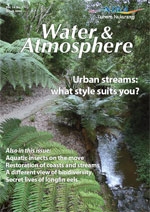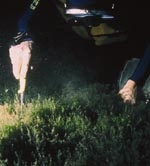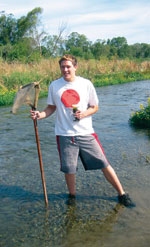PDF of this article (113 KB)

Off to a good start with BAYERBoost


Sean Gresham, who received one of five inaugural BAYERBoost environmental scholarships, writes, 'This summer I have been spending my time at the river, and I'm getting paid for it! BAYER group sponsored me to work on a 10-week environmental research project. I've worked with NIWA, Fish & Game, and ECan (Environment Canterbury) to study how the local river system (Waihi/Temuka/Opihi) is recovering, now that years of point-source pollution has ceased.'
As a Year 13 student at Geraldine High School, Sean heard about the BAYERBoost scheme through his science teacher, organised a project with NIWA freshwater ecologist Mike Scarsbrook, and secured ECan as project host. The project was designed as a follow-up to Mike’s 1988 study of benthic invertebrate communities that showed the river below the Winchester wool scour was 'degraded' and 'toxic' in places. There were several contributing factors to this degradation at the time of his study. Following public pressure, the scour’s resource consent was reviewed by ECan and conditions imposed which led the company to relocate to a new site near Timaru. Discharges ceased in 2004 and, now that the point-source factors are absent, the river has recovered, and shows very few signs of organic or toxic pollution.
Says Sean, 'I strongly recommend any young people out there with an interest in science and/or the environment to have a crack at this scholarship next year. It has been a very interesting, stimulating, and educational summer for me – and I'm certainly not out of pocket!'
For further information about BAYERBoost environmental scholarships, see: www.bayerboost.co.nz
For further information about this project, contact: Dr Mike Scarsbrook
Climate Change Competition: winners and workshop
In 2005, NIWA co-sponsored the New Zealand Schools Climate Change Competition, which required secondary students to analyse data from climateprediction.net, a climate-modelling experiment based at Oxford University. Students summarised their findings in a PowerPoint presentation; they also outlined their ideas about implications of their forecast, and considered what we could be doing now to reduce greenhouse gas emissions.
Most of the 56 New Zealand entries came from Hutt Valley High School and Upper Hutt College, home base of Phil Kendon, one of NIWA’s Royal Society Teacher Fellows last year. Phil worked with students in Year 9 and 10 classes to help them analyse the climate data.
The presentations were judged by Dr Jim Renwick and Sylvia Nichol of NIWA, and Dr James Crampton from GNS Science. First-place winners were Kelly Ye, Molly Tait, and Hana Small for Year 9, and Yvonne Tse and Janine Tiu for Year 10; all are students at Hutt Valley High School.
Presentations by Yvonne Tse and Janine Tiu, and by Jaymie Jarvis and Hollie Russell of Upper Hutt College (who placed second in the Year 10 category), were filmed and shown to delegates at the New Zealand Meteorological Society conference in November.
Upper Hutt College contributed by far the greatest number of 'model years' to the experiment – more than 3200. This, in fact, appears to be the biggest contribution by any school worldwide!
Phil plans to run two workshops to help teachers access and use the collected climate data from Upper Hutt College and the associated graphics package. The workshop will be held at NIWA in Wellington on 24 March and repeated at the SciCon science teachers' conference in Hamilton in July.
The climateprediction.net experiment has entered its second and final phase, and it is now possible to explore climate forecasts from the present through to 2080. A video-conference planned for later this year between schools in New Zealand, the United Kingdom, and Sweden will enable students to learn about potential climate change effects in other parts of the world, based on the latest data from climateprediction.net.
For further information, contact:
Phil Kendon, NZ S, M & T Teacher Fellow 2005, [email protected] or see: climateprediction.net
